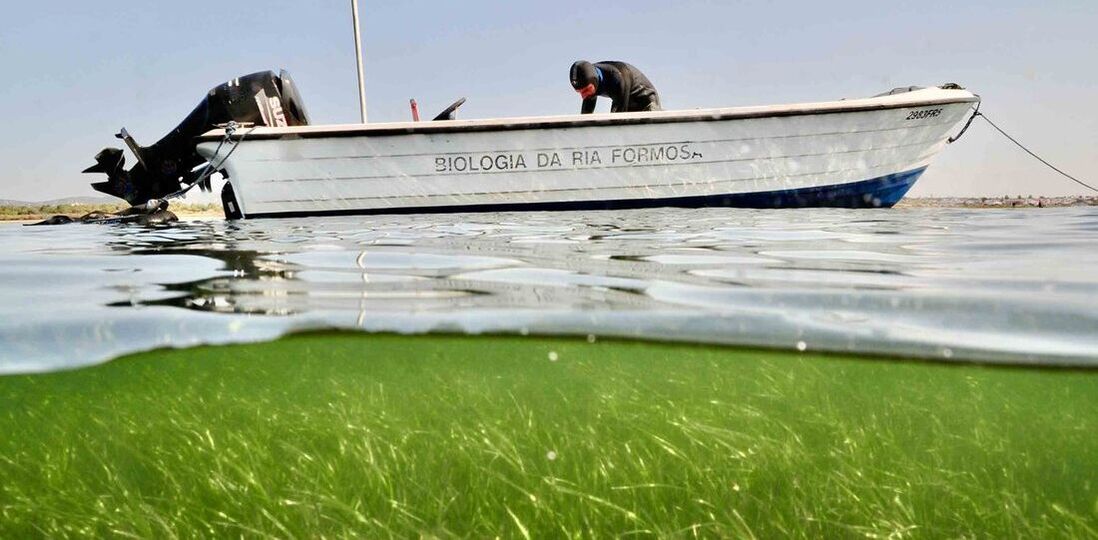SeagHorse project goals
The long-term goal of SeagHorse is the rehabilitation and sustainability of the seagrass habitats and seahorse populations of the Ria Formosa. The project is structured in the following components:
Seahorse habitat reconstruction
The reconstruction of a seagrass prairie is taking place in the seahorse sanctuary that was recently created (Edital 15/2020, Capitania do Porto de Faro), by means of transplants of two species, Cymodocea nodosa and Zostera marina, which are collected from a semi-natural donor site located in the Pilot Aquaculture Station of Olhão of the Portuguese Fisheries Institute (EPPO / IPMA). The collected plants are transferred to the sanctuary following specific methodologies, adapted to the particular morphology of each species.
Strengthening of the seahorse population
The reinforcement of the seahorse population in the sanctuary will be done from individuals produced in captivity at the Aquaculture Station of Ramalhete at CCMAR, from individuals collected in the Ria Formosa. The seahorse breeding program at CCMAR started more than a decade ago. The production of the two European seahorse species, the long-nosed seahorse (Hippocampus guttulatus) and the short-nosed seahorse (H. hippocampus) in captivity is now fully optimized. The seahorses will be transported from the CCMAR facility to the sanctuary, where they will be released into the seagrass prairie under reconstruction. They will be monitored seasonally by diving to assess growth and reproductive activity. Because these seahorse species have individual characteristics that allow for individual recognition by photo identification, a photo database of the released animals will be created prior to release. During seasonal monitoring, the fish will be photographed, measured, weighed, and immediately released.
Seahorse Biology
This action line will investigate the knowledge gaps on the population biology of seahorses in the Ria Formosa and the role of seagrasses as supporting habitats and food providers for seahorses. It includes the following tasks:
Population dynamicsSeahorse populations of the two species, H. hippocampus and H. guttulatus, are being seasonally sampled in the different habitats available in the Ria Formosa: seagrass meadows, unvegetated bottoms and meadows of the invasive green algae, Caulerpa prolifera. The abundance, size, age, condition index and reproduction of seahorses will be evaluated. Population dynamics parameters, such as mortality and production, will be estimated from the time series of size/age/weight frequency distributions of seahorses.
|
Trophic ecologyThe availability of prey for seahorses to feed on is being evaluated seasonally in seagrass and C. prolifera algae prairies, and on unvegetated bottoms. The main prey of both seahorse species, H. hippocampus and H. guttulatus, will be revealed by comparing the C and N isotopic signatures of the seahorses in each habitat, with those of the prey available in each habitat. The evaluation of factors determining feeding success of seahorses will be studied experimentally at the Aquaculture Station of Ramalhete, CCMAR. Experiments will be designed to test the effects of habitat type and complexity, prey availability and amount of light.
|
Educational and social value

The SeagHorse project will expand knowledge about the natural values of seagrasses and seahorses so that they can be appropriated by society, an essential condition for sustainability. Informed citizens are the driving force both for informal preservation actions and for demanding formal management and conservation actions by the authorities.
Teacher training actions will be carried out on the services and goods provided by the Ria Formosa seagrasses, and in particular on the research carried out in the project. Educational materials will be created about seagrass habitats and associated biota, including the iconic species of seahorses, so that they can be integrated into the educational standards and curricula of schools in the region.
Teacher training actions will be carried out on the services and goods provided by the Ria Formosa seagrasses, and in particular on the research carried out in the project. Educational materials will be created about seagrass habitats and associated biota, including the iconic species of seahorses, so that they can be integrated into the educational standards and curricula of schools in the region.
Participative seminars and governance
The knowledge gained from the SeagHorse project will be transferred to the stakeholders of the Ria Formosa, including key decision makers, conservation agents, media, and maritime tourism companies that exploit the image of the seahorse and offer seahorse tours. This training will take place in the form of at least two workshops where participatory working methodologies will be applied. The sessions will be structured by facilitators, using techniques that will engage and increase impact in an attractive way through practical experiences of sharing and reflection among peers, promoting the involvement of participants.




